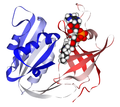Methemoglobin: Difference between revisions
CSV import |
CSV import |
||
| Line 18: | Line 18: | ||
{{stub}} | {{stub}} | ||
<gallery> | |||
File:NADH_cytochrome_B5_reductase_1UMK.png|NADH cytochrome B5 reductase 1UMK | |||
File:Methemoglobin_Crystal_Structure.png|Methemoglobin Crystal Structure | |||
</gallery> | |||
Revision as of 21:10, 23 February 2025
Methemoglobin (British English: Methaemoglobin) is a form of the oxygen-carrying protein hemoglobin, in which the iron in the heme group is in the Fe3+ (ferric) state, not the Fe2+ (ferrous) of normal hemoglobin. Methemoglobin cannot carry oxygen. It is bluish chocolate-brown in color. In humans, methemoglobin is not a problem unless the level exceeds 1%, when it begins to compete with oxygen for binding sites, potentially causing methemoglobinemia.
Structure and function
Methemoglobin is produced in the body by oxidation of the ferrous iron in hemoglobin to ferric iron. This can occur through the action of certain drugs or toxins, or as a result of a genetic disorder. Methemoglobin cannot bind oxygen, which means it cannot carry oxygen to the tissues. This can lead to cyanosis, a bluish coloration of the skin and mucous membranes, and to hypoxia, a lack of oxygen in the body.
Methemoglobinemia
Methemoglobinemia is a condition characterized by elevated levels of methemoglobin in the blood. It can be congenital, due to a genetic disorder, or acquired, due to exposure to certain drugs or toxins. Symptoms can include cyanosis, headache, fatigue, shortness of breath, and in severe cases, seizures or death. Treatment typically involves administration of methylene blue, which reduces methemoglobin back to hemoglobin.



